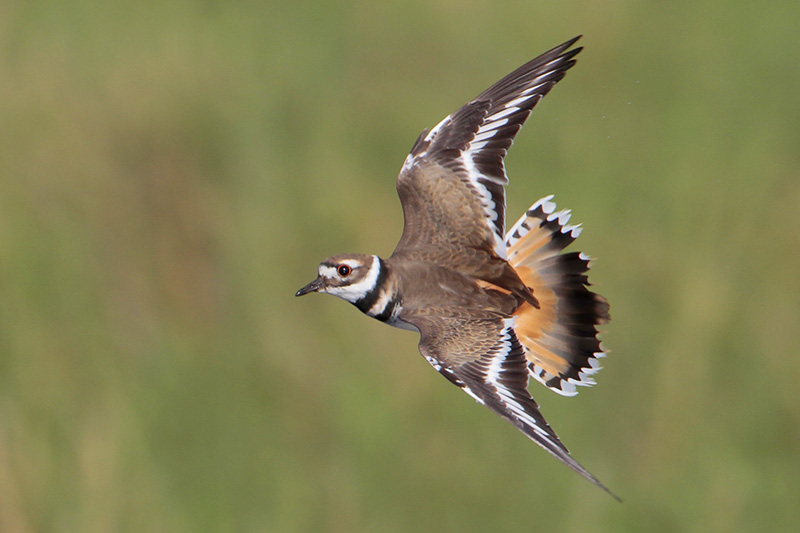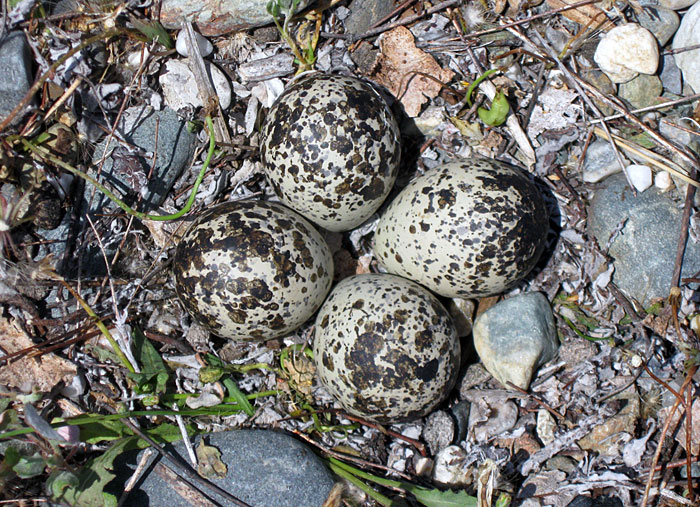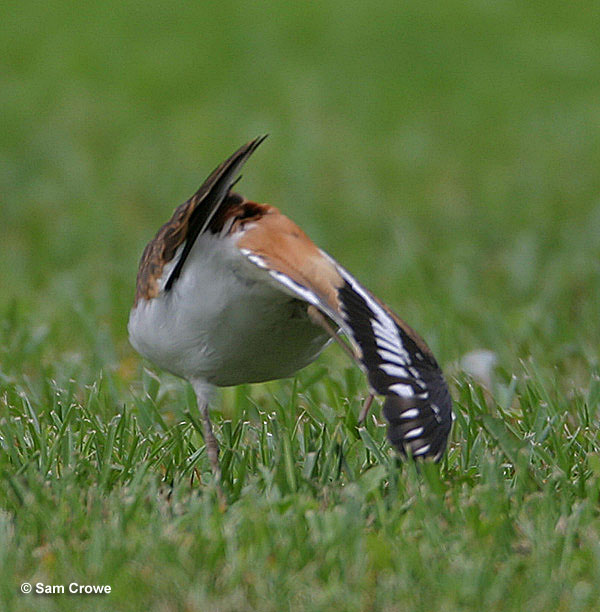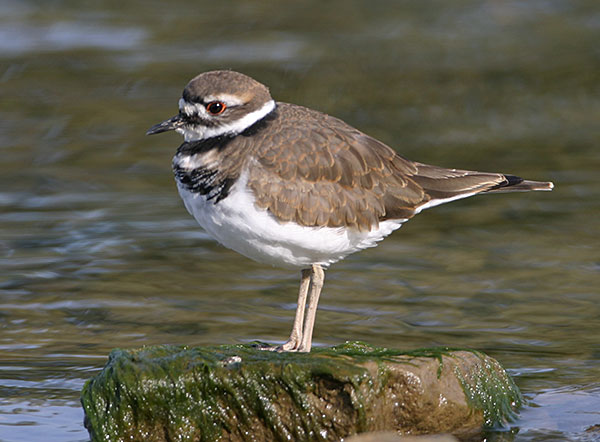The Killdeer is a shorebird that you can see without going to the beach. Killdeer are plovers. Plovers are a group of wading birds with an extensive range.
It’s not uncommon to see these birds on golf courses, lawns, parking lots, and athletic fields. These light brown birds run in quick bursts. They do this so they can stop every so often to check if they’ve scared any insects or their progress.
Killdeers have big eyes, large, round heads, and short bills. They’re lean, slender birds with long wings and pointed, long tails.
On this page
Breeding Male
Breeding male Killdeers have white underparts and brownish-tan upper parts. Their white chests are barred with two black bands.

Killdeer in flight
Killdeer’s faces are brown and marked with white and black patches. Their rump is bright orange-buff which is visible in flight.
They’re 7.9 to 11.0 inches (20 to 28 centimeters) long and weigh 2.6 to 4.5 ounces (75 to 128 grams).
Females look identical to breeding males.
Juvenile
Juveniles look similar to adult birds. They have white underparts and brownish-tan upper parts. Their chests are white and barred.
Additionally, two black bands can be seen. Their faces are brown and marked with white and black patches. Finally, their rump is bright orange-buff which can easily be seen while they’re in flight. The only difference is juveniles have buffed fringes and the presence of tail-down.
Young Killdeer will leave the nest not long after hatching. The parents will care for the juveniles, but the young birds feed themselves. The first flight is at around 25 days.
Habitat
Killdeer inhabit areas like grazed fields, sandbars, and mudflats. It’s not uncommon to see them around town on lawns, athletic fields, driveways, airports, golf courses, and parking lots.
Usually, the areas that Killdeer inhabit don’t have vegetation taller than one inch.
Of course, you can also find Killdeer near water, but they’re a unique shorebird in that they love dry areas too.
Killdeers usually make a scrape nest, but they can sometimes opt for rooftops. They usually lay 4-6 eggs that hatch in 22-28 days.

Diet
Killdeers consume invertebrates. Some of the most common prey of Killdeer are snails, earthworms, crayfish, beetles, aquatic insect larvae, and grasshoppers.
These birds have been known to follow plows on farms in hopes of being able to find any insect larvae or worms that have been unearthed. Killdeers will also consume seeds in agricultural areas. In addition, they’re opportunistic foragers and have even been observed eating dead minnows and hunting frogs.
Killdeers will find food by patting the ground either on the surface or underneath the water, with one of their feet. It’s presumed that they do this because this motion will scare prey that is burrowed underground. These birds have also been known to probe the mud with their beaks and chase prey on the ground.
However, the primary behavior that Killdeers have developed involves the bird running toward its prey and then stopping and waiting. Once the prey starts to move again, the killdeer will rush toward it and grab it with its bill.
Behavior
Killdeers will run short distances and then stop in search of earthworms and insects on the ground. Even though these birds can often be found in high-traffic areas, they’re still very shy when it comes to humans.
When a Killdeer sees an intruder, they’ll stop and bob up and down. The best way we can describe it is it almost looks like they’re hiccupping. If they have a nest nearby, Killdeer will distract predators by loudly calling, bobbing, and running away.
Additionally, they’ll feign injury to distract the predator and draw them away from their nest. In fact, Killdeer are masters of the broken-wing display. They’re considered one of the best performers of this technique among all bird species.

Range
The Killdeer is the most widespread plover in North America. Their breeding range extends from Quebec to Yukon and south.
Killdeer can be found year-round across the southern parts of the United States, Mexico, along much of the West Coast, and lower elevations of the Rockies. Killdeer that breed in the southern parts of the U.S. and along the West Coast are year-round residents, but Killdeer that breed in Canada and the northern U.S. migrate south to Central America and Mexico.
Wing shape
Killdeer have long, slender wings and a wingspan of 18.1 to 18.9 inches (46 to 48 centimeters). White stripes can be seen on their wings, but they are only visible when the bird is flying.
Fun Facts
- Killdeers symbolize staying focused. These birds show up to remind you that you’re on the right track to achieving your goals and dreams. Additionally, these birds are very dedicated to protecting their nest and young, even if that means putting themselves at risk. This makes them a popular spirit animal for those that are protective and value their family.
- Killdeers love to nest on gravel rooftops. However, this is a hazardous place for them to raise their young. Adults lure chicks off the roof once they’re big enough to leave the nest, and there have been instances of chicks dying due to them falling off the building.
- Killdeer are excellent swimmers. Both adult and young birds have no trouble swimming in fast-flowing waters.
Vocalization
Killdeers are very noisy and talkative birds. Their calls are hard to miss due to them being high-pitched and shrill. These birds got their name from the sound of their call. When they vocalize, it sounds like they’re saying “kill-deeah-dee-dee,” “kill-dee,” or “kill—deer’’.
Frequently Asked Questions
Why are Killdeers called Killdeers?
Killdeer got their name from the sound of their call. When they vocalize, it sounds like they’re saying “kill-deeah-dee-dee,” “kill-dee,” or “kill—deer’’.
Do Killdeers migrate?
Some Killdeer migrate, and some don’t. For example, Killdeer that breed in the southern parts of the U.S. and along the West Coast are year-round residents, but Killdeer that breed in Canada and the northern U.S. migrate south to Central America and Mexico for the winter.
How long does it take for Killdeer eggs to hatch?
It takes 22 to 28 days for Killdeer eggs to hatch.


